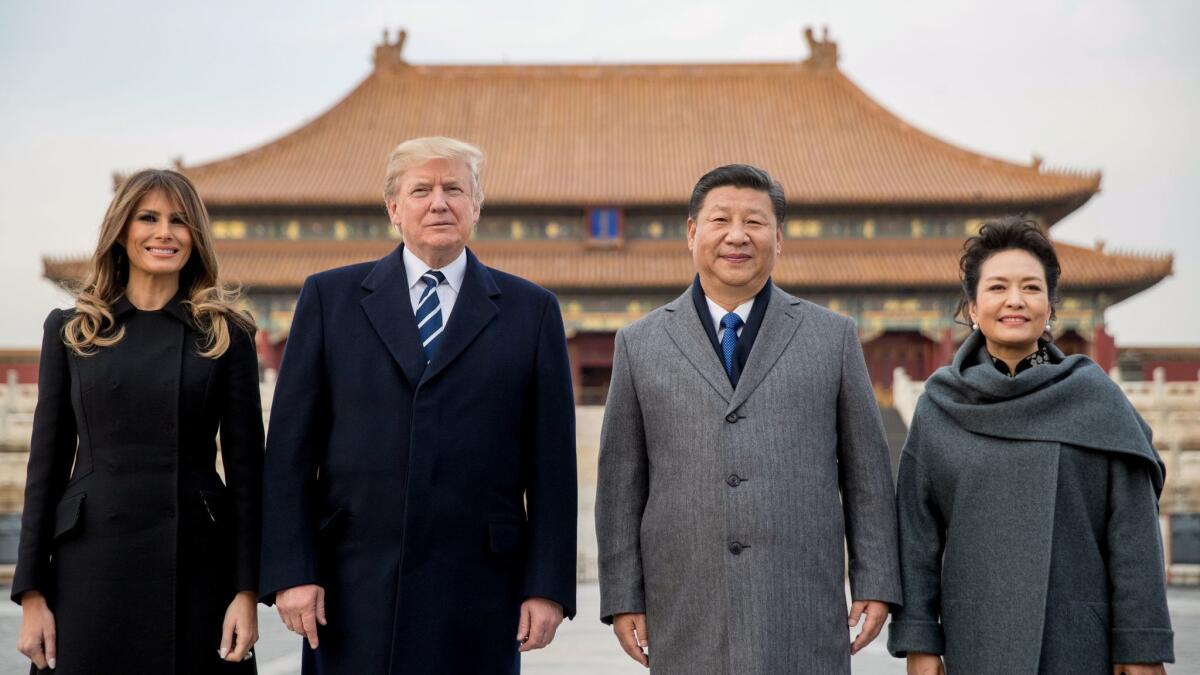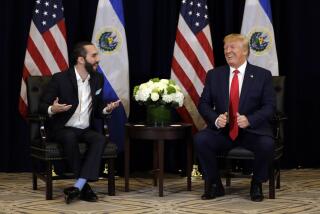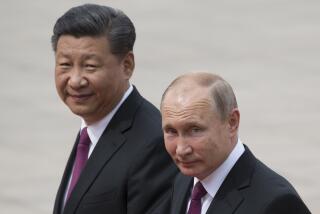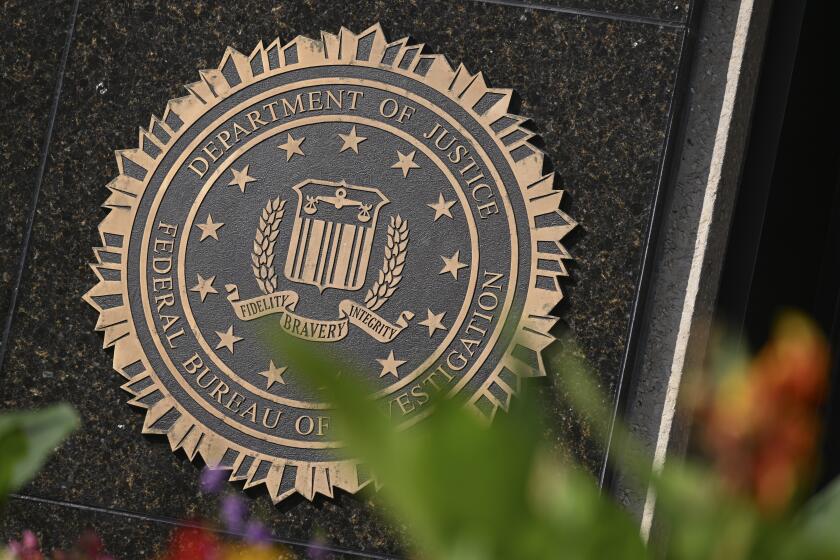Trump is flattered across Asia, and flatters back, but returns with little in hand

In the photo, President Trump and Chinese leader Xi Jinping stand shoulder to shoulder in front of the yellow-tiled palace where emperors ruled the Middle Kingdom, as China called itself for centuries.
It was the first time a U.S. president had stood for a portrait with the head of China’s Communist Party in the middle of the ancient Forbidden City, what has long been the psychic heart of China. The next day the country’s state-controlled newspapers ran the image across their front pages.
Trump had been in Beijing only for a few hours, but already Xi had gotten what he wanted: to be seen, inside China at least, as an equal to the American president. What remains unclear is what Trump has gotten.
Just hours after his arrival, the president had demonstrated how willing he was to be flattered and to flatter back, while getting little in return, at least for now.
Trump’s grand reception in China was a highlight of his 12-day, five-country tour of Asia, where the specter of Beijing’s superpower aspirations is at the center of every other relationship the United States has in the region. Uneasy partners tried to game out how the U.S. intends to counter China’s rise while persuading it to bring its full weight to bear on resolving the North Korean nuclear crisis.
They still don’t have answers. Like China, each country — Japan, South Korea, Vietnam and the Philippines — gave Trump the red-carpet treatment, and for the proud president, that alone seemed proof of his diplomatic success.
“It was a red carpet like I think probably nobody has ever received. That really is a sense of respect, perhaps for me a little bit, but really for our country, and I’m very proud of that,” Trump said on Monday in the Philippines, his last stop.
He and top advisors say that before long the shows of respect will translate into action on trade and North Korea. “The fruits of our labor are going to be incredible,” Trump said.
They aren’t evident yet. China remains resistant to cracking down on North Korea economically, despite Trump’s entreaties. As for trade, the president announced no firm deals or actual progress toward bilateral agreements to reduce U.S. trade deficits with the Asian nations, aside from claims of up to $300 billion in business deals that American and foreign companies promised. Flying home Tuesday, Trump suggested the figure could reach $1 trillion, but observers suggested even the $300-billion sum is inflated.
The president’s challenge is that he is asking the nations to do more on North Korea even as he is demanding they get less on trade.
Also, he sent mixed messages. Alongside Xi in Beijing, Trump blamed his predecessors for trade practices that, as a candidate, he’d labeled as economic rape, and he applauded China for getting away with it. Once he’d left, in Vietnam Trump returned to attacking China.
In a speech in Seoul before the South Korean National Assembly, Trump first described at length the horrors of life in North Korea under the oppressive Kim dynasty, then invited Kim Jong Un to the table to talk about ending his nuclear program. He also posted the sort of provocative tweet — calling Kim “short and fat” in response to Kim’s taunts — that so worries allies like South Korea living within close range of North Korea’s missiles.
In China, Trump had to spend down some of his guanxi, or influence, with Xi almost immediately after three UCLA basketball players were arrested there on suspicion of shoplifting. Trump asked Xi to help resolve the case quickly, and on Tuesday the players were allowed to board a flight to Los Angeles.
The take-away for the countries other than China may have been Trump’s sheer presence, signaling that America wants to remain a player in the region despite Trump’s repudiation of the Trans-Pacific Partnership, a multilateral trade pact brokered by then-President Obama and intended to counter China’s economic clout.
Yet there were also signs of how Trump’s “America first” retreat from multilateral trade leadership had left the United States somewhat sidelined. One of the most concrete results of the Asian summits Trump attended was a separate resolution among the other 11 TPP signatories, led by Japan, that they would enforce the trade agreement without the United States.
Trump bolstered his relationship with Japan by visiting that country first, golfing and dining with Prime Minister Shinzo Abe, who seemed willing to play sidekick in Trump’s buddy movie; when Abe accidentally tumbled into a sand trap, Trump walked nonchalantly away.
In the Philippines, a longtime ally that the administration is eager to keep from China’s sphere, Trump displayed a stunning rapport with President Rodrigo Duterte despite the strongman’s sorry record on human rights, going so far as to join Duterte in publicly mocking Obama for his estrangement from Duterte.
Trump’s critics were quick to criticize his trip as long on pageantry and short on substance. Senate Democratic leader Charles E. Schumer called Trump’s tour “a flop” and a missed opportunity to do more to counter China.
“He seemed far more interested in pomp and circumstance — red carpets, fancy meals and the flattery of foreign leaders — than advancing American interests in a region that is increasingly looking to China for leadership,” Schumer said.
Administration officials suggested that tougher moves on trade, particularly with China, and on security are in the offing. White House Chief of Staff John F. Kelly summarized the trip as “setting up the discussion” about trade imbalances and North Korea.
Trade Representative Robert Lighthizer — a longtime China-trade hawk — Commerce Secretary Wilbur Ross and Treasury Secretary Steven T. Mnuchin have been considering a variety of punitive measures to squeeze China on trade if it doesn’t respond to Trump’s cajoling.
Back home, the president will be under pressure from both Democrats and the anti-globalists in his party to pursue a harder line against China, said Ely Ratner, a former senior advisor to Vice President Joe Biden. “The happy veneer of the visit is on pretty thin ice. I don’t think it will last long.”
Though Trump promised a major announcement at the White House on Wednesday or Thursday to provide more details about the results from the trip, top aides sought to lower expectations.
“While we appreciate the long hours and the effort that our Chinese counterparts have put into those trade discussions, quite frankly, in the grand scheme of a $300- to $500-billion trade deficit, the things that have been achieved thus far are pretty small,” Secretary of State Rex Tillerson told reporters in Beijing.
Administration officials say they got further in their efforts to enlist China in confronting North Korea, which relies on Beijing’s economic support, though they still lacked a concrete plan on what may be the toughest issue that Trump inherited. “The Chinese are ponying up,” Kelly said.
Tillerson said Xi and other Chinese officials “have been very clear and unequivocal they will not accept a North Korea with nuclear weapons.” But the two powers do not agree on tactics, timing and how much pressure to put on Pyongyang despite what Tillerson said was “a lot [time] exchanging views.”
The Chinese believe sanctions are beginning to hurt Kim’s government and need more time.
The two issues — trade and North Korea — also dominated Trump’s discussions with close allies. Those too were complicated. Trump tried to reassure Japan that it does not need to pursue its own nuclear program, while demanding that the country spend more money to defend itself.
Trump sought to unify the region under what he calls an “Indo-Pacific” umbrella, but that remains a challenge. The term suggests the administration’s aim to enlarge the circle of major democracies, notably to include India and Australia, behind a regional strategy of open trade channels and resistance to China’s efforts at dominance. In Vietnam, at the annual Asia-Pacific Economic Cooperation summit, Trump referred repeatedly to the importance of national sovereignty, a signal of support to smaller nations fretful about China.
Although other nations at the summit declared success toward salvaging the TPP, Trump made no tangible progress on the one-on-one trade deals that he has promised as an alternative to sweeping multilateral pacts.
“If you are against the Chinese alone, China will fire back,” warned Michael Green, who was an Asia advisor to President George W. Bush. TPP and other such multilateral alliances make the United States part of a united front with other large markets, like Japan and Canada, making it better able to withstand any tit-for-tat trade retaliations by China, Green said.
“When China gets tough,” he added, “we will find ourselves feeling isolated.”
Bierman reported from Manila and Bennett from Beijing.
Twitter: @ByBrianBennett
More to Read
Get the L.A. Times Politics newsletter
Deeply reported insights into legislation, politics and policy from Sacramento, Washington and beyond. In your inbox three times per week.
You may occasionally receive promotional content from the Los Angeles Times.












